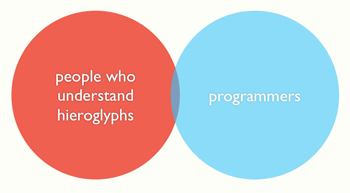Earlier this year I was attending the dConstruct web conference in Brighton, UK. These sorts of conferences bring together plenty of like-minded people and friends I only get to see a few times a year. After the conference a few of us stuck around a few days to relax, recuperate and chat.
Brighton is also the home to one of Britain’s many follies. In 01803, the Prince Regent decided to build a reconstruction of an Indian style riding school and stable near the sea front. This later became the Royal Pavilion. In the proper tradition of British follies, what comes next would fit right in!
The day after dConstruct, Mike, Remy, Josh and I all sat in the park next to the Brighton Dome and ate our ice cream. When Mike astutely pointed out the Egyptian exhibit that was on at the museum. We all thought it was interesting, then he came-up with a zinger of a comment. He said, “They did a pretty good job translating”. The title of the exhibit was “The Egyptians”. I thought to myself, that it was a pretty good name for the exhibition. He then went on to tell us that the hieroglyphs on the sign read “The Egyptian People” and the museum adequately captured this in their translation. I think we all sat there a minute to take in what just happened. Someone amongst us could read 05000+ year old text! Then first thing that came to my mind was how we could harness this power in some useful way.
Now, my suggestion was not the best, nor most practical, but somehow this folly was the one that we ran with.
If you were to draw a Venn diagram and one circle was the people who could read Egyptian hieroglyphs and another circle computer programmers, the overlap would be pretty slim. So the usefulness of my idea was both NOT useful and NOT very funny except to the tiny group of people in that overlap.
I wanted a t-shirt that said, “Hello World” in hieroglyphics!
Now, the history of the Hello World Program goes back a ways! Anyone who has ever taken an introductory computer programming course has written a Hello World Program. It’s the first thing you learn how to do, get the computer to echo back to the screen the text “Hello World” just to demonstrate that things are working and you have control of the machine.
I was quickly informed that Ancient Egyptian didn’t have a glyph for the letter ‘L’ because it didn’t exist in their language, atleast not till later when it was added by the British. Now I’m not one to let a missing letter of the alphabet stop me, so we enlisted the some help.
Mike was kind enough to email some old colleagues from school and friends who stayed true to the path of Egyptology and now work in various museums around the UK. Now, it must have been a strange request to get an email asking someone to translated HELLO WORLD into hieroglyphics, I mean, it’s not everyday someone asks you these sorts of questions. But like any proper geek, Egyptian, weather, computer, climbing, photography, or other, they are more than happy to help out anyone who has taken an interest in their subject matter. So after a few back and forths we dug a bit deeper into the translation issues.
I was willing to bend the actual HELLO WORLD text infavour of an equivalent saying, such as GREETINGS EARTH. With all their technological achievements, Egyptians were only just short of creating the computer, and when they did, they would have needed something to output to prove it worked. GREETINGS FROM RA, THE SUN RISES, or something as prolific.
The result that we got back from translation was “Welcome, the entire land”. Now, it is mind boggling to think that it’s been 05000+ years since the first hieroglyphs and it is highly unlikely that this has EVER been written before. “Welcome, the entire land” is a greeting from a long extinct ideology, language and culture. “Welcome, the entire land” is a warm greeting.
The following was translated from the glyphs to English. The glyphs themselves would be pictorially translated as the following:
- Flowering reed with legs.
- Flowering reed.
- Double score.
- Legs to signify movement.
- Pestle.
- Flowering reed.
- Flat alluvial land with grains of sand.
- Mouth.
- Bundle of flax stems showing the bolls.
- Mouth.
- Road bordered by shrubs.
- Horned viper.
This forms the hieroglyphic which is read from left to right, top to bottom. You can tell because of the way the first glyph is facing. It creates a very flexible system that can be used to make beautifully stylized writing.
From the basic design I began to stylize it to make it more interesting, less academic and more artsy.
I was so proud of this folly that I got my wish and printed it onto a t-shirt. I can now wear it knowing a tiny fraction of the population can translate it, and those who can probably won’t get the joke (and vice versa).
For anyone else who thinks it is an interesting folly, you are more than welcome to take the translation and design and apply it to anything you wish. A coffee mug, hat, your own shirt, anything. The designs are public domain, I think the Egyptians would have wanted it that way, after 03000+ years of having disappeared, the term of copyright would have expired several times over by now anyway.
Downloadable files
Special Thanks to Mike Stenhouse for contacting translators and the Egypt Exploration Society for conducting translations. I think everyone involved enjoyed this strange project as much as I.



